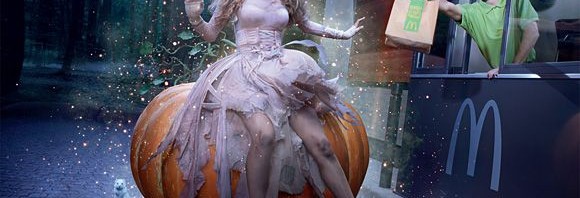Of all of children’s TV, my favorite show is Arthur, the adventures of that beloved, perpetually-eight-years-old aardvark and all of his friends and family that has been on the air since the year I was born, making it the second-longest running animated series in history. A season 5 episode of Arthur entitled “Just Desserts” (link to watch) (IMDb citation) has always been one of my favorites. After Arthur eats too much candy, he is thrown into an imaginative dream sequence …
The Folklore of Folklore Conferences
There was a moment during the Western States Folklore Society 75th annual meeting last month where I realized how specific and special folklore studies scholars are. I was attending this conference, like my peers Ariel Peterson and Lauren Redding, for the first time under the guidance of Professor Jill Rudy. We three students came prepared to present research about our various areas of fairy tale scholarship, but that was only represented a fraction of the time we spent at the conference. It was during the …
One Fairy Tale Girl’s Experience at a Very Serious Academic Folklore Conference
On the final day of the Western States Folklore Society conference, while waiting for Dr Rudy’s presentation to begin, I had a brief conversation with Dr. Tok Thompson of the University of Southern California. After introducing myself and answering affirmatively that this was my first time at a conference, he said “Oh, be careful, they’re addicting. Once you go to one you never want to stop going to them.” It seems like a strange concept. How can listening to presentations …
Continue reading “One Fairy Tale Girl’s Experience at a Very Serious Academic Folklore Conference”
BYU Humanities Center Blog Crosspost: Folklore, Mentoring, and the Work of Art
The following post was originally published on the BYU Humanities Center blog. The post was written by Professor Jill Rudy, a Faculty Fellow for the Center. As a folklorist, I recognize this year’s Humanities Center theme, The Work of Art, resonates with issues of memorable and mundane learning. Is art something we must travel to see and to admire? Is it unique, costly, and rare? Does it exist simply for its own sake? Can art be part of the everyday? …
Continue reading “BYU Humanities Center Blog Crosspost: Folklore, Mentoring, and the Work of Art”
Fat Fairies, Mash-Ups, and Advertisements: the Hypnotic Effect of TV Fairy Tales
On April 7-9, 2016, the FTTV Project Participants traveled from Provo, Utah to Berkeley, California to present their panel at the Western States Folklore Society Conference. Ariel Peterson was first up with her analysis of fairy godmothers that usually appear as fat fairies (whether in actual body type or symbolized by a round dress). Lauren Redding showed off her data about gender comparisons and inclusion of animal characters that she compiled from the FTTV Database. She was able to display many interesting …
Continue reading “Fat Fairies, Mash-Ups, and Advertisements: the Hypnotic Effect of TV Fairy Tales”
Concluding the Promotional Small-Screen Fairies Series
In his 1979 book, “Breaking the Magic Spell,” Jack Zipes shared the story of Priscilla Denby, a researcher who spent an entire day watching TV in 1969 logging all the traditional folklore and fairy tale items featured in shows and commercials. In 1969 Denby logged 101 themes in one day of television. In 2016 we live in a time described (sometime jokingly, other times seriously) as Peak TV. As more channels and online content providers attempt to stake out ground …
Continue reading “Concluding the Promotional Small-Screen Fairies Series”
Fairy Tales in the 2010’s Remix Culture
Harvard law professor Lawrence Lessig published a book in 2008 titled “Remix: Making Art and Commerce Thrive in the Hybrid Economy,” which hypothesized about the societal effect of the internet, specifically for the way in which it gave rise to the remix culture. Lessig recognized a trend in the rising popularity of derivative works that combine or edit together existing materials to produce something new. (One quick example is Pogo’s “Alice,” a song spliced together from sounds from Disney’s Alice …
The Digital Age of the 2000s
In the new millennium the buzzwords of the first decade were globalization and technology. Across the globe the internet, computers, and cell phones were bringing people together and changing the way people lived their lives. A pair of studies at the start and the end of the decade showed a jump from 6% to 62% of Americans having in-home internet access. Cell phone popularity surged as well, fueled by advances in text messaging and mobile internet accessibility. In a very …
The 1990s Corporate Takeover
In Marina Warner’s short history of the fairy tale book, Once Upon A Time, she posits that one of the primary functions of the fairy tale is the sharing of familiar stories with an audience. She goes on to explain “the stories’ interest isn’t exhausted by repetition, reformulation, or retelling, but their pleasure gains from the endless permutations performed on the nucleus of the tale, the DNA as it were.” While fairy tales have a long history of corporate usage, …
Destination: Western States Folklore Conference
Western States Folklore Society is celebrating 75 years at their 2016 meeting! Three of the FTTV Project Participants are going to UC Berkley this April for the WSFS Conference to present the panel entitled “Fat Fairies, Mashups, and Advertisements: The Hypnotic Effect of TV Fairy Tales.” If you are in the area we would love to have you join us! Take a look at each of the abstracts below. The first paper is titled “Fat Fairies: Stereotype, Body Type, and Personality …
Continue reading “Destination: Western States Folklore Conference”

